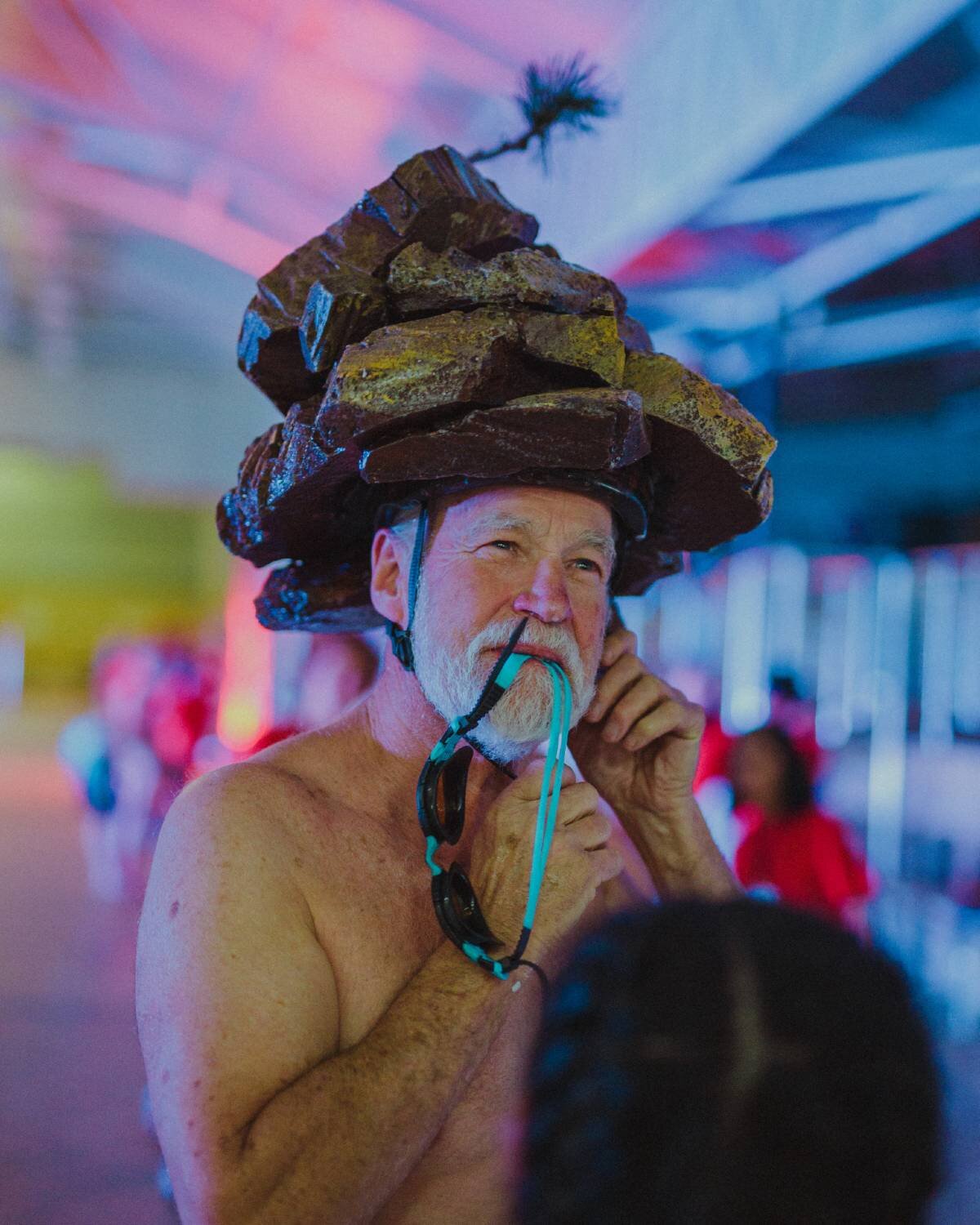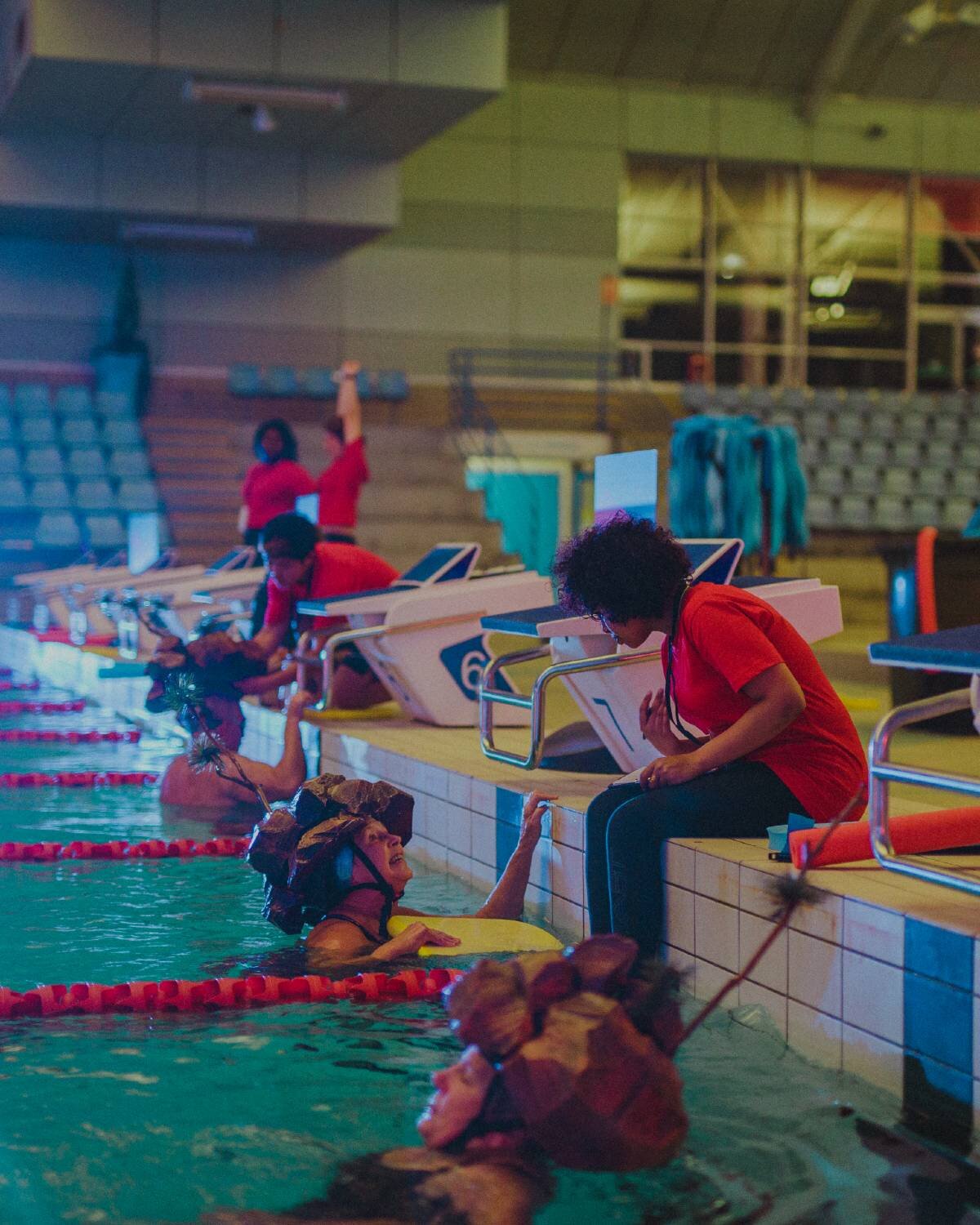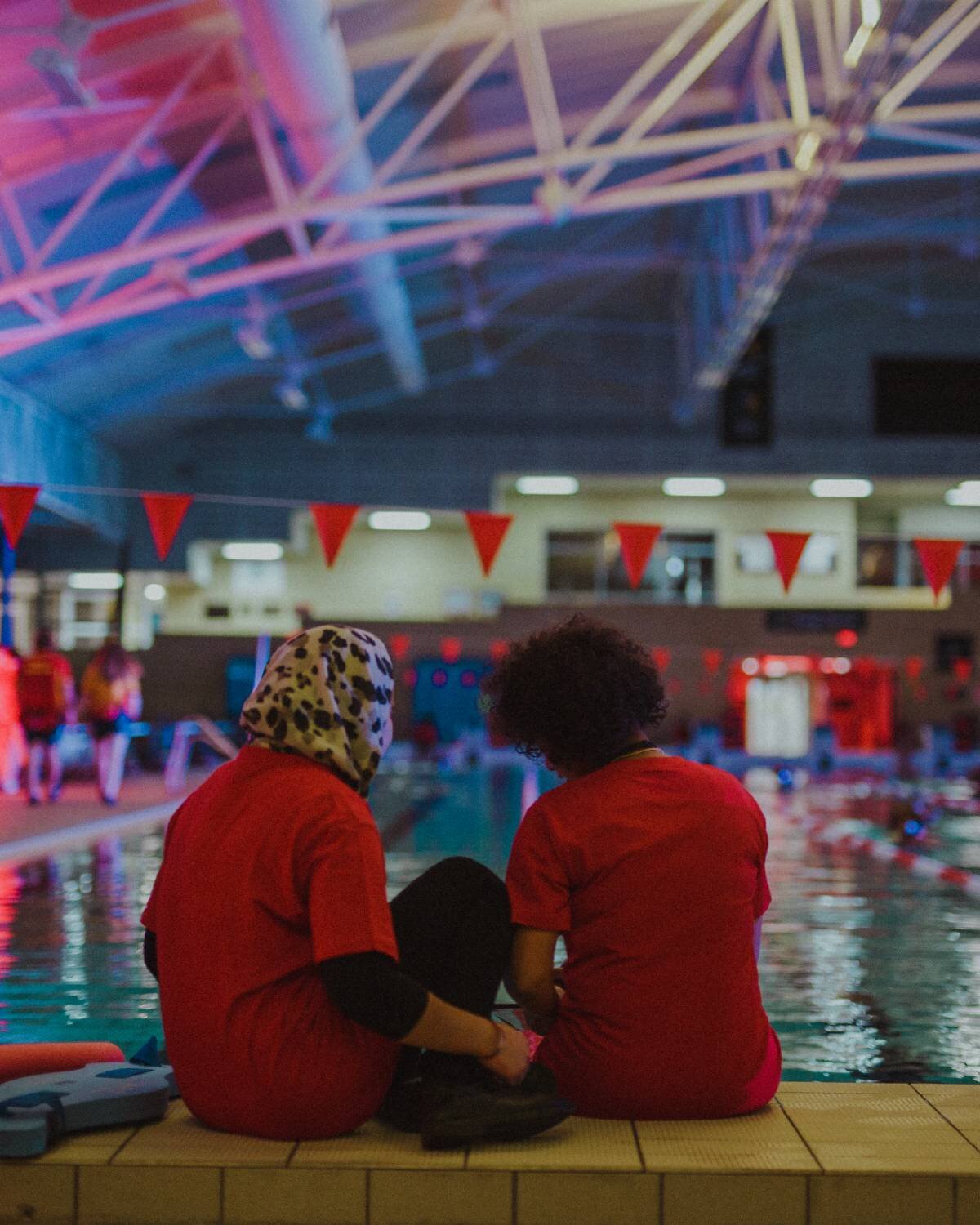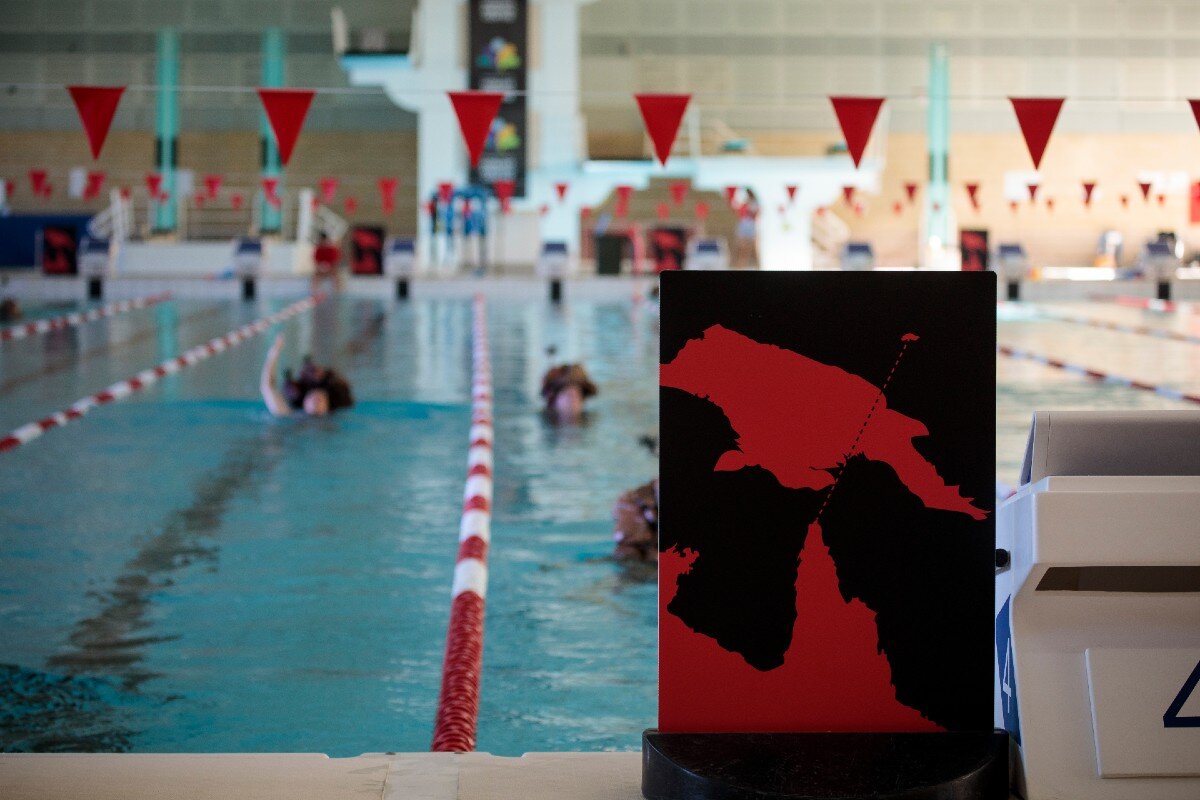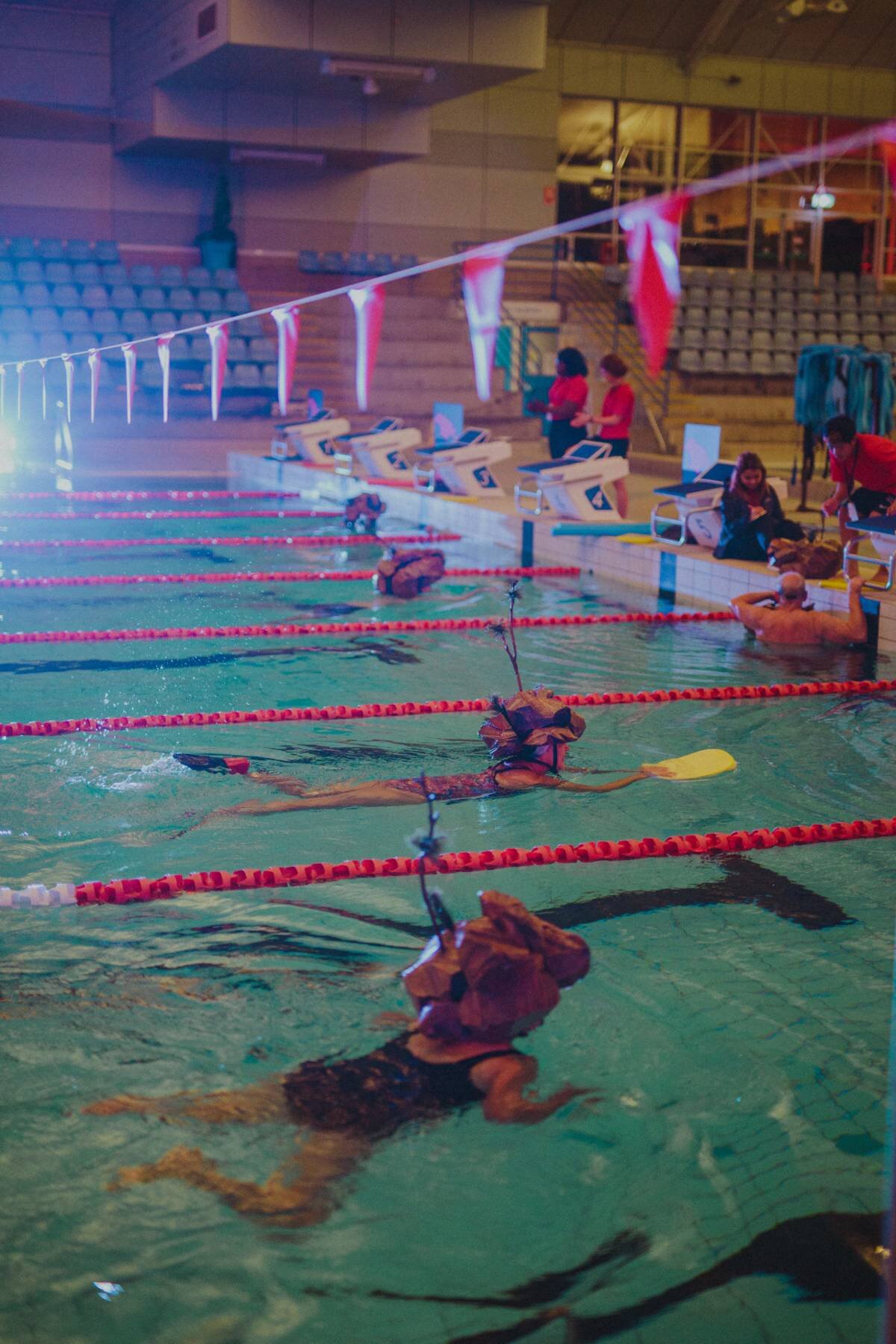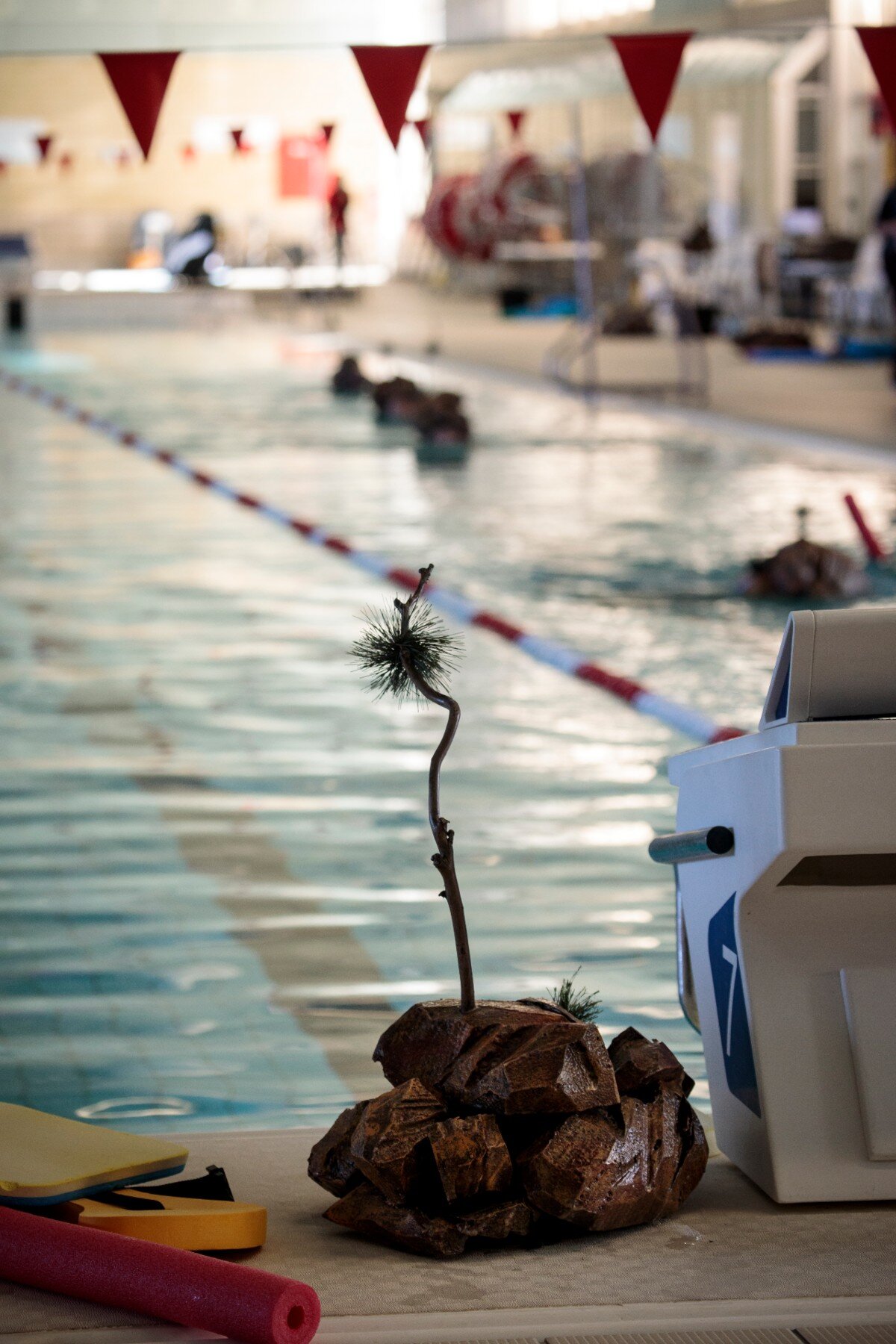Welcome Territory - Selena de Carvalho responds to Tanya Lee’s ‘Landing’
ISLAND | ISSUE 154Selena de Carvalho immerses herself in Tanya Lee’s ‘Landing’
Image: Remi Chauvin
This faux island strapped to my head is almost choking me. I’ve gulped a lot of chlorine and swum more laps than I have in years, and now a weird, underutilised muscle in my shins is starting to ache. It’s 10.30 pm on a winter Saturday and I am weary, but determined. I’m swimming 50-metre laps of the Doone Kennedy Hobart Aquatic Centre pool for art.
Each lap feels like a small victory yet simultaneously monotonous, because in reality I am swimming to nowhere. But at one end of the pool, next to the diving block, the smiling face of Sasmika Rai – a young woman who migrated from Nepal several years ago – beams at me, pulling me from my thoughts. Sasmika’s experience of caring for me while I swim matters to me. I feel accountable to her. I want Sasmika to feel as though this has been worthwhile. So I push through my own lack of fitness and deeper into the conceptual conundrum of Landing, from my position of privilege.
*
The distance between Manus Island and Australia is around 431 kilometres, excluding the landmass of Papua New Guinea in between. In Landing, a participatory, durational artwork conceived by Tanya Lee, audiences are invited to swim the distance between Australia and Manus Island as a continuous relay lasting 24 hours – in this case, from 6 pm Saturday 9 June until 6 pm Sunday 10 June as part of Tasmania’s winter festival, Dark Mofo. According to Alison Wilkes, Landing’s production manager, over the 24 hours of the work, 339 people including young children and elders from the community collectively swam more than 8000 laps. At the conclusion of the work, they were just 31 kilometres short of Manus Island.
*
Nala Mansell opens the work by welcoming us to country in front of a 3 metre map of Northern Australia and Manus, illustrating the proposed sea passage. The attendees seem as diverse a crowd as you may expect at the local pool, extending beyond the stereotypical art gang.
Swimmers stride forward to enter the world of the work. Many appear to be in their early teens (swim squads, I later find out), alongside mature-aged participants, solo or coupled. On the far side of the pool the swimmers are fitted with island headdresses: adapted bicycle helmets adorned with styrofoam rocky outcrops and protruding faux greenery similar to casuarina. This image of the work is absurd and entertaining: something akin to wearable ikebana; human bodies crowned with islands.
“This image of the work is absurd and entertaining: something akin to wearable ikebana; human bodies crowned with islands.”
Participants are welcomed by young people from the local migrant community who lead short sessions of preparatory stretches, arms swimming through air, bodies squatting, bobbing up and down on the tiles, out of time and perfectly theatrical. Encouraged by their hosts, ‘the islands’ enter the pool, swimming in groups or alone in the lanes. They glide through artificially blue water, parallel, moving to their own current. I am drawn to one woman in a solo lane: her wild, curly hair topped by a cute one-rock-island, her dark skin shiny in the water.
Moody music fills the aquatic centre and I feel a gush of emotion. It is beautiful and sad, and funny! In the ridiculousness of this scene, humour gives the audiences permission to engage with the seriousness of the topic. It’s a tactic I have employed in my own work, and I can appreciate the cunning use of the absurd as an entry point to the underlying political and humanitarian issues Landing addresses – the incarceration of refugees in Australia’s off-shore detention centres. These places, intended to deter asylum seekers from boarding boats, emit regular reports of trauma, abuse and neglect.
Research shows that when we embody the ‘other’ in an act of play or participation, we increase our capacity for empathy. Our imagined experience supports an increase in perception and understanding.
I speak with Madeleine Habib about her swim. She captains the Antarctic vessel Aurora Australis. Over the past three years, in off-seasons, she has captained a ship in the Mediterranean, rescuing asylum seekers, many of whom cannot swim. Madeleine chose to wear the largest island she could find (an act of martyrdom?). She swam for three hours, finding the idea of a virtual swim to safety compelling and meaningful. For Madeleine the pool was a metaphor for a cage, a confined space for pacing. She expressed a sense of care and accountability for fellow swimmers. Ultimately, her experience of participating in Landing is multiple; personally moving, an act of homage.
*
Watching from the pool grandstand as the work begins, I feel I could be in a modern colosseum, observing a new conceptual sport. Songs are played as human islands move back and forth. Islands – those idyllic landmasses on which we cast fetishised holiday fantasies; that we imagine as sites of buried treasure. Self-contained environments of evolutionary curiosity. Isolated geological prisons used by colonists for centuries.
“Islands – those idyllic landmasses on which we cast fetishised holiday fantasies; that we imagine as sites of buried treasure. Self-contained environments of evolutionary curiosity. Isolated geological prisons used by colonists for centuries.”
Later, caught within the colourful, extravagant world of the opening of the latest Mona exhibition, my mind stretches back to the pool, then reaches further out to bodies of water, where perhaps someone, somewhere is striving towards a shore.
I remember a time when I was a young activist standing on one side of a fence, feeding tools through gaping wire into hungry hands. Emptying my toolbox, roof-racks and pockets, as the only human response I could muster when meeting someone with their lips sewn together.
*
In the dressing room after my first swim, I chat to Hirut Weldemichael Sebika as she dries her prune-skinned toes. Hirut is the swimmer I had noticed several hours earlier wearing the small one-rock-island. She met artist Tanya Lee the week before, a serendipitous crossing of paths. Tanya asked if Hirut would be part of a press image for the work, and Hirut, moved by the request, agreed. Hirut dedicated her weekend to swimming as much as she possibly could, ‘swimming as a way to pay respect for all those who lost their lives’. When I meet her, Hirut has already spent four hours in the pool, and she plans to return the next day for more laps.
*
Landing is a brave work. It requires endurance. Migrant hosts and production crew are as much part of the performance as are the participants. Tanya Lee says she has experienced waves of panic navigating this political and personal territory, worrying if she has said the right thing, does someone disagree, was it said in the right way? In making Landing she is carefully aware of not exploiting people’s stories or objectifying hardship. She says a mentor encouraged her not to be scared to address big political issues. Landing does potentially expose Tanya and her collaborators to criticism, yet, thankfully, she is compelled to proceed.
*
Fourteen-year-old Rose Castle is a state-level swimmer. Since she was seven, she’s swum eight times a week. Participating in Landing, Rose found the notion of ‘swimming for a cause’ motivating and ‘eye opening’ as well as surreal. After each 40-minute swim, the migrant hosts of Landing asked participants to share their first experiences of swimming. Rose was shocked to hear that her host had not learned to swim until arriving in Australia as an adult. With swimming being such a strong part of the nation’s cultural identity, it’s difficult for many Australians to imagine not having this skill.
I asked Rose if she felt that Landing had been a valuable experience, and whether it may influence her in the future. She said that she didn’t have a great deal of knowledge about social and humanitarian issues, but that this type of community awareness raising had already led her to have conversations with her peers, encouraging them to think beyond their parents’ perspectives. Rose noted that she planned to do more research on humanitarian issues for her next school assignment.
*
Landing began for me when I encountered the first powerful image online. It had me thinking and feeling long before I entered the pool. Building up to my swim, I encouraged people to join me in the pool. I felt a strange sense of responsibility for the work’s success. But what is success when we are thinking and talking about such complex, sensitive and multifaceted issues? This work speaks of humans, who are strong and brave enough to believe in a better life on the other side of the world, and who are consequently punished for their courage through incarceration.
Swimming laps with an island strapped to my head may have no direct connection to Australia’s immigration policy, but this awareness-raising art of solidarity is poetically potent. This work connects communities through unique relationships of role-play, care and stamina. Landing is a celebration, a lamentation and a nuanced meditation on politics and intercultural exchange. ▼
This essay was supported by the City of Hobart through a Creative Hobart grant.
Tanya Lee is a Western Australian artist, working across sculpture, performance and drawing. Her studies included a year at the École Nationale Supérieur d’Art de Dijon in France, before completing her MA (Fine Art) at Curtin University.
tanyalee-art.com
Landing was presented as part of Dark + Dangerous Thoughts, Dark Mofo 2018. Landing was produced by Emma Porteus and Alison Wilkes assisted by Ainslie Macaulay, in partnership with SITUATE Art in Festivals.
The following people collaborated with Tanya Lee as coaches and storytellers: Surjen Magar , Sarafino Enadio , Narbada Thapa , Zeinab Eldayar , Susmita Khadal , Nadia Azizabadi , Samira Salmani , Tha Dar (Dar) , Baktash Hamdard (Bakki), Leyla Tajik, Sasmika Rai , Murad Abdi , Haben Gezae , Leya Gebretinsaie, Kwot Omod, Fatema Fazeli , Magda Gamar, Lila Chuwan, Mohammad Nazari , Zabidullah Mohammadi (Zabih)
Images:Top: A Landing participant swims in front of the map showing progress of the ‘swim’ between Australia and Manus Island. Photograph by Dark Mofo/Rémi Chauvin, courtesy Dark Mofo
Gallery images: A Landing participant adjusts his ‘island’ (by Jacob Collings); Landing coaches/storytellers encourage swimmers (by Jacob Collings); coaches/storytellers Fatema Fazeli (L) and Haben Gezae (R) watch from the blocks (by Jacob Collings); an island headdress awaits the next participant (hotograph by Dark Mofo/Rémi Chauvin, courtesy Dark Mofo)
This arts feature appeared in Island 154 in 2018. Order a print issue here.
If you liked this piece, please share it. And please consider donating or subscribing so that we can keep supporting writers and artists.


